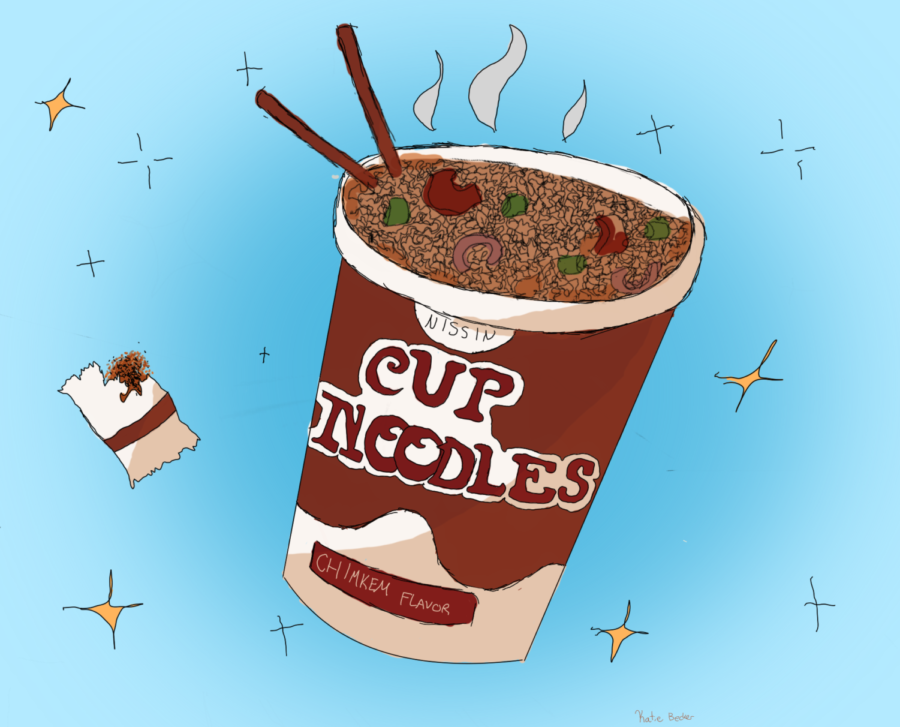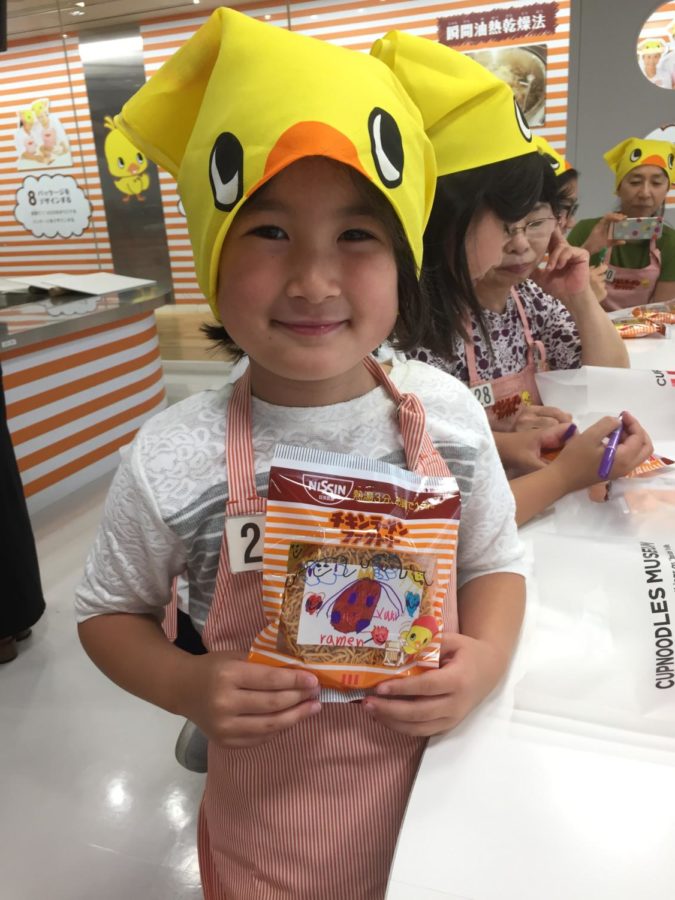The History of Instant Ramen
Katrina Becker’s artwork depicting Cup-a-Noodles
A college student’s favorite meal and both the cheapest and easiest food to make. You guessed it, it’s instant ramen! Have you ever thought of how and why it might have been created? These days, I’m sure many of us can’t imagine living without it. What would we eat when we only have 10 mins to make dinner? What kind of meal would fulfill our hunger for around 4 dollars? Let’s not dillydally any further and jump into its amazing history!
In 1958, a Taiwan-born Japanese man named Momofuku Ando ‘purposefully’ creates the first set of instant noodles in his shed by frying regular old noodles, and rehydrating them back to revert them to their old form. Keep in mind that this was something he already had a vision for. It wasn’t something that popped out of nowhere, but was instead something that was in the works for a while. His main motivation for it was a simple desire to eat noodles easily and with quick access. After Japan lost in WWII, they certainly were not stable financially and resource-wise, which meant that food was sometimes provided by the US. But at the time, the US didn’t really have noodle culture. (Or more so, anything other than spaghetti and maybe lasagna) The US rations mostly consisted of bread, which he was getting very tired of.
Later in the year on August 25th, Momofuku creates the official branding and listing for the ramen, which is released onto the market with the title ‘Chikin Ramen’, which basically just translates to Chicken Ramen. He also was the founder of Nissin, a food company that you probably know of because of their… instant noodles! Unlike the Cup-a-noodles you know of today, the first instant ramen was the pack kind, in which the person would pour boiling water over a block of pre-seasoned noodles in their own bowl. Of course, because they needed to reduce costs (even though they were six times the price of fresh noodles at the time), the vegetables were not included in the equation. Because of this many people (if they could afford it at the time) made custom ramen by adding their own meats and vegetables to it.
After a couple years of major sell-outs, business is booming! Momofuku accomplishes this with his very good advertising skills after years of being in the marketplace. (Fun fact, he was arrested twice, and both times were connected to the various other companies he was part of, or founded) The company later decides to separate the noodles and the flavoring of the soup to enhance the flavor. (As I have said before, keep in mind that the ramen was not yet in handy-dandy styrofoam cups, but still in packets)
Around 1970, Momofuku travels to the US and sees people there eating without their traditional bowls, but instead with kitchenware that was disposable (ex. paper plates, plastic cups, plastic utensils). From this, he concluded that it might be a good idea to make a container for the instant noodles so that it was made ready to eat. It would insure that there were dirty dishes, and minimal clean-up required.
In 1971, the holy grail of ramen, the cup-a-noodles are invented. The instant noodles now have a styrofoam cup, dehydrated vegetables, and various layers within the cup where each element was separated. After another boost in popularity, Momofuku realized that he could make a profit in other countries as well and that he could use certain opportunities to spread his beloved noodles around the globe.
Throughout the rest of his years, Momofuku manages his company and creates many variations of his cup noodles, including low-sodium, seafood, and curry until he dies of heart failure in 2007. To this day, his ancestors take care of his company, the current CEO being Koki Ando, with, as you can see, the same last name as our dear founder Momofuku Ando.
Nissin also creates cup noodles, curry rice, udon, and antibiotic drinks (kind of like a Yakult). They are all affordable, and Japanese people’s favorites.
Mini Story: So, how is it Made?
Interestingly enough, I actually have personal experience to answer this question. In the summer of 2018, I actually went to the original factory and made some of my own instant ramen!
First, they gave us a little kerchief with the mascot on it to keep our hair from getting in the way, and in the food, and of course, aprons. They gave us the ingredients for the dough, and my grandmother and I mixed them together in a pretty big bowl. Then, we passed the mixture through a hand-crank smoother which made the dough have a flat, smooth surface. Then, we switched stations and put the flattened dough through a noodle slicer. It was actually pretty tough!
After we were done with the noodles, we put them in a bag and handed them off to one of the fryers. The fryers would take a clump of our noodles, put them in a little compressor, and then fry the little disk for around 15 minutes. It even had a little dimple on top to put an egg on it! (Unlike the U.S.’s eggs, Japan’s eggs are safe to eat raw, and has almost no chance of passing on illnesses)
While we were waiting, everyone started to decorate their bags that we got with permanent markers. I don’t quite remember what I drew that day, but in the picture above, my little sister seemingly drew a princess.
We finally got our little ramen disks back, we quickly placed them into our custom bags. A kind lady later came over and helped us seal our bags up so the noodles wouldn’t spoil.
For those wondering, the ramen was pretty good! It was definitely way different than the artificial-ish ramen that we have today. It tasted more of soy sauce than chicken, and the noodles were still a little hard, but it still somehow had a nostalgic taste!
(Keep in mind, this whole article is about the ‘modern’ instant noodle. Technically, ‘instant’ noodles were first invented in Taiwan, where something called the ‘Yi Noodles’ already existed. However, they weren’t the greatest thing in the world in terms of innovation, and that’s why I’m more focused on the ‘modern’ version. +In terms of general audiences, Cup-a-noodles and the brand Nissin are way more popular and well-known.)
Facts and Evidence collected from:
https://www.cupnoodles-museum.jp/en/osaka_ikeda/about/
https://www.businessinsider.com/momofuku-ando-instant-ramen-cup-noodles-2021-1
https://en.wikipedia.org/wiki/Instant_noodles#:~:text=Instant%20noodles%20were%20invented%20by,worldwide%20under%20many%20brand%20names.
https://www.tokyoramentours.com/post/instant-ramen-history
Also credits to Katrina Becker! I think she did a really great job on the art!
(sorry that my request was confusing!)
Meet me, Mika H.
Hi, my name is Mika, and I am an 8th grader at BTMS. I like math and reading webtoons and manga. I also like judging and tasting food,...

Hello! I am a photographer and visual arts person for our school's paper, Bulldog Brief! I hope to entertain our readers and bring excitement to our website.






Ashley Casper ¦ Jan 3, 2023 at 9:01 pm
Instant ramen is the best. I eat it all of the time, especially at like 3 in the morning
Max Trac ¦ Dec 7, 2022 at 10:21 pm
Man this article was written so well and the art was really cool this makes me think a lot about instant noodles and how much sodium it has.
Lilly Charters ¦ Dec 7, 2022 at 10:00 am
I love ramen!